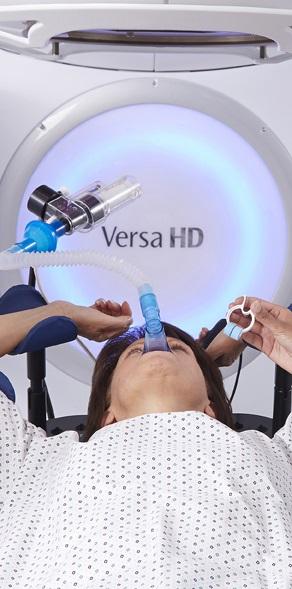
Stereotactic body radiation therapy (SBRT) employs significantly higher per fraction radiation doses than conventional radiotherapy. Therefore, for patients with aggressive cancers, SBRT can be a more potent, therapeutic treatment option leading to better local control. However, an enduring challenge in delivering SBRT for some cancers — lung and liver tumors for instance — has been the impact of the patient’s breathing on tumor motion.
For patients with a liver tumor, OHSU has been using an Elekta system called Active Breathing Coordinator (ABC) to help patients manage their breathing during SBRT beam delivery — essentially “freezing” the tumor’s position and enabling the beam to concentrate on the lesion, while sparing surrounding normal tissues.
Liver SBRT with ABC is an alternative to free-breathing (FB) SBRT for patients who can perform a few sustained breath-holds (BHs) during treatment. The main downside of FB SBRT is that the treatment beam must cover the full range of the tumor’s motion during respiration, which means we have to irradiate a larger volume of surrounding normal tissue to ensure we hit the target. Although the FB liver SBRT workflow is simpler and less involved than that of BH (i.e., ABC) liver SBRT — and FB treatment delivery is quicker — the overriding goal in any radiation treatment is to maximize the dose on the target and minimize the irradiation of normal tissues. For many of the 70 to 80 liver cancer patients treated with SBRT per year at OHSU, using ABC accomplishes this goal.
ABC Workflow
ABC is involved in all phases of BH liver SBRT: CT simulation, treatment planning, daily set up and treatment delivery. Total liver SBRT dose is
50 Gy (10 Gy x 5).
CT Simulation
The facility assesses the patient’s eligibility for a BH treatment (i.e., ability to perform a BH without undue difficulty) by asking patients to take several BHs and timing their duration. For suitable candidates, up to two BH scans are taken, a long one for planning and a short scan to assess reproducibility. A third scan is usually required without BH just in case the patient’s ability to hold their breath for a long period becomes compromised during treatment and the decision is made to re-plan without the BH.
Planning
Both the long and short BH scans are evaluated— to ensure the anatomy is constant between both — by examining the fusion between scans. For SBRT, we are primarily assessing liver position reproducibility. A plan is then developed based on the long BH scan. The dosimetrists are asked to plan 3-D conformal or 3-D arc treatments (i.e., without modulation) with flattening filter-free beams ([FFF], i.e., Elekta’s High Dose Rate mode on the Versa HD treatment machine) to maximize delivery speed, thereby minimizing the number of BHs the patient requires for treatment. volumetric modulate arc therapy (VMAT) is used for some liver SBRT cases, but the MLC field modulation requires slower FFF dose rate and gantry speed, which, puts the number of BHs required on par with that required for a 3-D multi-field plan.
Daily Set-up
The patient is imaged using ABC for BH employing our Versa HD system’s cone beam CT (CBCT) kV imager. We can manually pause the CBCT during acquisition; therefore while the CBCT scan time is longer than a single BH, we can still acquire the full scan by starting and stopping the beam as needed. The final CBCT is evaluated for both patient positioning and BH reproducibility since it is a composite of several BHs.
Treatment
Following the BH parameters in the daily set up, the patient is treated. The number of BHs during treatment will vary depending on the dose we prescribe, the length of time patients can hold their breath and the number of fields and modulation of the plan. The treatment beam is turned on only during BH (via automatic response beam gating); the longer the patient holds his breath, the longer the beam will be on and the sooner the treatment will be completed. As noted, BH ABC-assisted liver SBRT takes longer to deliver (Fraction 1, 90 minutes, Fractions 2-5 45-60 min) than FB liver SBRT (Fraction 1, 60 min., Fractions 2-5, ≥ 30 min depending on the number of fields), but for patients who can tolerate BHs and a little extra time on the table, it is worth the enhanced tumor targeting/sparing of healthy tissues.
Case study supplied by Elekta. Contributors: Oregon Health Sciences University Department of Radiation Medicine; Monica Kishore, MS, medical physicist, assistant professor; Charlotte Kubicky, M.D., Ph.D., radiation oncologist, associate professor; Wolfram Laub, Ph.D., MBA, medical physicist, director of medical physics and associate professor.



 December 11, 2025
December 11, 2025 









